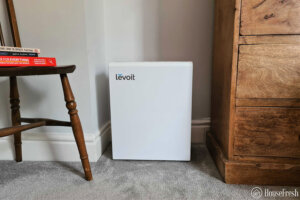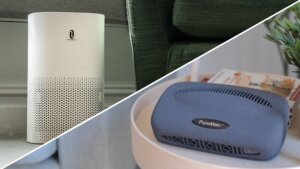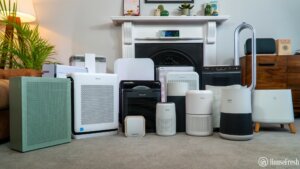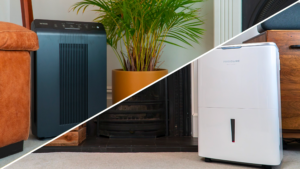CADR is the standard measurement for how much air an air purifier can clean in a certain period of time. This means that not all air purifiers clean at the same rate, even with the same size room coverage. CADR is measured in cubic feet per minute (CFM).
As of 2022, the United States Environmental Protection Agency, (EPA), recommends air cleaners with high CADR ratings as part of their advice on keeping indoor air clean.
When making a major purchase, you probably look at a product’s reviews, price, and specs. But what about its CADR rating? If you’re buying an air purifier, CADR score is crucial to ensure it suits your needs.
In this article, we’ll go over everything you need to know about CADR, including what it stands for, what it shows, how it’s calculated, how it’s tested, what it can’t do, and much more.
CADR is an acronym for Clean Air Delivery Rate. It’s commonly used to measure the capabilities of an air purifier or air filter and refers to its ability to clean a specified volume of air.
As well as air purifiers, CADR is also used for other applications such as measurement of smoke removal from a home during a fire, the effectiveness of an air conditioner in removing formaldehyde, the ability of foam boards to filter dust in factories, and even measuring the effectiveness of bug zappers that claim to kill mosquitos.
How is CADR calculated?
CADR is calculated based on three standard particle sizes:
According to the Association of Home Appliance Manufacturers (AHAM), CADR shows the rate of removal of certain particle pollutants, ranging in diameter from 0.09 – 11 microns, from a 1,008 ft3 test chamber by an air purifier.
These pollutants are (followed by size range and the maximum CADR associated with each particle pollutant):
- Engineering tobacco smoke (0.09-1.0 micron): 450
- Arizona Road Dust, also called ISO fine dust (0.5-3.0 microns): 450
- Paper mulberry pollen (5-11.0 microns): 400
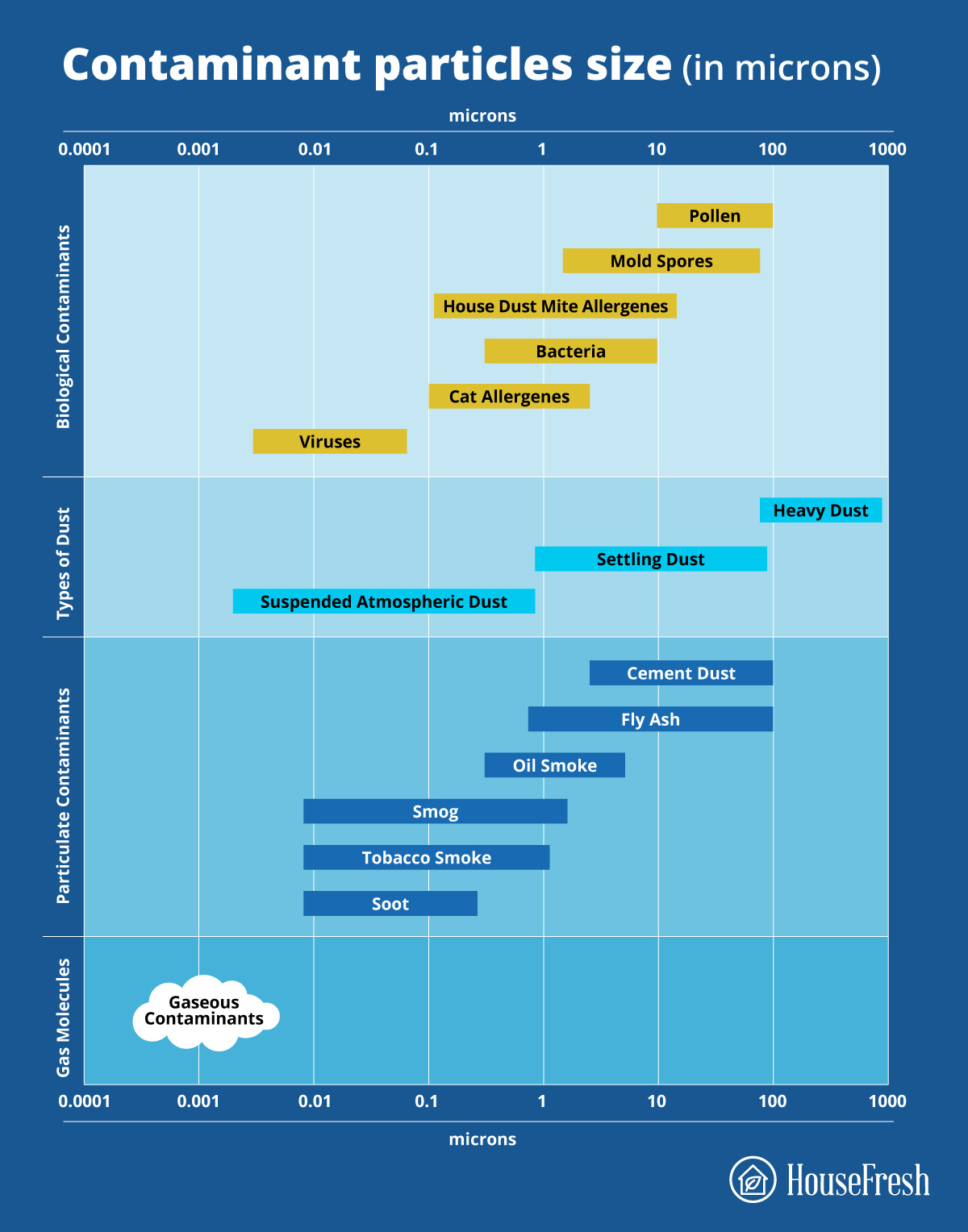
The CADR number represents how well the air purifier cleanses the air within a space or how quickly (in cubic feet per minute) it removes particles of each size from the air. CADR ratings are determined using a test chamber to measure how quickly an air purifier can clean the air in a room, regardless of its size.
Air purifiers are usually rated for small (100-250 sq ft), medium (250-400 sq ft), large (400-600 sq ft), and extra-large (600-1000 sq ft) spaces, but that’s just a general guideline for what might work best in any given room size; your actual needs may differ based on your own personal preferences or health concerns. If you have asthma or COPD, for example, you may want to opt for an air purifier with a higher CADR rating in order to minimize your exposure to allergens in your home.
How is CADR tested?
The Association of Home Appliance Manufacturers (AHAM) developed the CADR measurement system to determine the overall effectiveness of air purifiers in removing particles from the air.
In order to determine a unit’s CADR, AHAM uses three separate tests to measure efficiency for tobacco smoke, dust, and pollen. Each of these tests are conducted in specially designed rooms with controlled environments that allow testers to deliver the same pollutants at consistently high concentrations repeatedly.

Over time, AHAM has developed standardized protocols for each test, making it possible to effectively compare the performance of different models.
But, why is CADR important?
The benefits of having a high CADR rate are better health, reduced allergy symptoms, and less maintenance. If you have an air purifier with a low clean air delivery rate, it will work harder to clean the same amount of air.
An efficient unit will run at lower speeds and be able to filter bacteria, allergens, viruses, and dust. CADR doesn’t give you an indication of how well an air purifier will work with gases or VOCs as these are not part of the AHAM CADR test.
A common question that comes up is, “What is ACH?” As opposed to CADR (clean air delivery rate), which measures the amount of air that a machine filters during operation, ACH (air changes per hour) measures how many times the air in a room or space is replaced during an hour of operation.
The number of air changes per hour can be used to determine how quickly a given area will be filtered. For example, if a room has an ACH of 4, it means that all the air in that room will be filtered four times every hour. So, now we know what ACH means, but how do you use it?
Well, if you’re looking for a new purifier to purchase, you should consider what spaces you’ll be using it in and what sorts of pollutants may be present there. For example, an office space with very few people won’t have as much pollution as a small bedroom with one or more people sleeping in it.
For bedrooms and other densely populated rooms where people spend a lot of time, it’s good to have a machine that can filter the air several times per hour; this might mean finding a machine with an ACH of 6 or above.
How can you calculate which CADR score you should look for?
A rule of thumb when choosing an air purifier is to ensure the unit you pick will be powerful enough to clean the air in a room at least four times per hour. A great (and simple!) way to do this is by focusing on its CADR rating.
Measure your room and use our handy calculator to uncover which CADR score you should be looking for:
CADR controversies
CADR is not a perfect way to evaluate air cleaning performance, and some air purifier manufacturers (such as IQAir and Molekule) refuse to send their units for testing.
- IQAir believes that the CADR test unfairly supports hybrid systems that use ionizers to make particles heavier before cleaning them using a HEPA. They argue that many units will perform far less effectively beyond the short 20-minute test that is involved in CADR classification.
- IQAir and Molekule bring up the fact that CADR doesn’t indicate effectiveness for VOCs and gases, and this is true. Suppose you are looking for performance relating to VOCs or gases. In that case, you should look at the sheer amount of adsorption filter (such as lbs of activated charcoal) as the CADR score would only relate to particulate matter and would be useless in evaluating VOC or gas removal.
- CADR also doesn’t consider microscopic particles; units that remove large particles quicker will have a higher score than those that remove smaller particles but take longer to remove big particles.
We still believe that CADR should be used when evaluating air purifiers as long as you are aware of its potential shortcomings. Here at HouseFresh, CADR is just one of many factors we use in combination with our own testing for particle and VOC removal. We wish that the U.S. would force manufacturers by law to share CADR data like the Chinese government – we found the Dyson HP04 CADR on the Chinese website, but it was completely missing in the U.S.
Common questions about CADR, pollutants and air purification
The short answer is that CADR is not a rating designed to measure virus removal. CADR ratings are designed to measure the amount of smoke, dust, and pollen that a filter removes in one minute. But in simple terms, the higher CADR rating, the better air filtration.
When you measure your room, you’re trying to determine how much space you have for the air purifier to clean. To get this number, all you have to do is multiply the length, width and height of your room together.
The resulting number will tell you how many cubic feet are in that space. That number is going to tell you approximately how many cubic feet of air your purifier needs to be able to clean each minute for it to be effective in that space.
The difference between HEPA, True HEPA, and medical-grade HEPA is their ability to filter particles. HEPA filters are the most basic type. They block out 99.97% of airborne particles that are 0.3 microns or larger in diameter.
True HEPA filters take this one step further by blocking out 99.7% of airborne particles that are 0.3 microns or larger, as well as 90% of airborne particles that are 0.1 microns or larger (in addition to everything blocked by a regular HEPA filter).
Medical-grade HEPA filters are the best option out there for people who have severe allergies or asthma since they block out 99.9995% of airborne particles that are 0.12 microns or larger (in addition to everything blocked by a regular True HEPA filter)
Final thoughts
In layman’s terms, if you have a filter with a CADR rating of 250 on it, that means it will remove 250 cubic feet of smoke per minute. If you have a filter with a CADR rating of 350, then it will remove 350 cubic feet of smoke per minute. The difference between those two filters is 100 cubic feet per minute.
This is why CADR ratings are not an effective way to measure the ability of air purifiers to remove viruses from the air. Because viruses are so small and move so fast, they can’t be measured in terms of how much space they take up or how long it takes for them to move through a room.
There are other ways to measure how well an air purifier removes viruses from the air. Still, unfortunately, there isn’t currently any standardized method for measuring virus removal in air purifiers yet.
SOURCES
- AHAM Verified. (2014). Method for Measuring the Performance of Portable Household Electric Room Air Cleaners. ahamverifide.org
- Harriman, L. (2019). New Guidance for Residential Air Cleaners. epa.gov
- IQAir. (2021). Air purifier long-term performance: CCM vs CADR. iqair.com
- Talhelm, T. (2019). Why a Weaker Filter Actually Makes a Stronger Purifier. smartairfilters.com
- U.S. Environmental Protection Agency. What is a MERV rating?. epa.gov



